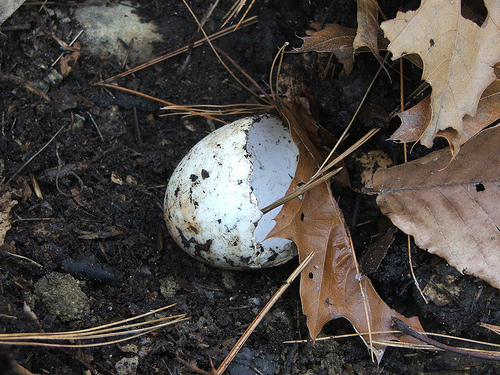We’ve reached part 4 of this riveting story of how calcium and other nutrients make it into into the soil and thence into our vegetables and thence into our own bodies (and into chicken eggs). We’ve had some cliffhangers already, so be sure to check out parts one, two and three.
~
4. Solubility, carbonation and chemical weathering
It is the reaction of calcium and calcium compounds with water (see last part) that makes them soluble. Solubility or dissolution is the process by which a “solute†forms a homogeneous mixture with a “solvent†(here water).
This happens as the solute molecule breaks down and its ions dissociate. The positive ions attract the partially-negative oxygen in H2O and the negative ions attract the partially-positive hydrogen in H2O. The ions thus get spread out and become surrounded by the water molecules. The dissolution is complete, or in equilibrium, once it’s all been spread around. (source)
One calcium compound is more soluble than another. Calcium carbonate (our eggshell) has a very poor solubility (47 mg/L at normal atmospheric CO2 partial pressure and 25 degrees C). As we shall see, this is important for gardeners who plan to enrich their soil with eggshell calcium, but I will come to that later.
However, if carbon dioxide is also present, that carbon dioxide will react with the water to form carbonic acid (H2CO3), which is a weak acid – it’s the bubbly in our soft drinks. This carbonic acid will in turn react with the calcium carbonate to form calcium bicarbonate (or calcium hydrogen carbonate). So
CaCO3 + CO2 + H2O → Ca(HCO3)2
Calcium bicarbonate is five times more soluble in water than calcium carbonate—in fact, it exists only in solution.
This is the main process by which carbonate rocks of the Earth’s crust are weathered. As we saw, if water is saturated with carbon dioxide, it produces a mild carbonic acid. This is what happens with (unpolluted) rainwater (water plus atmospheric CO2), which has a pH of around 5.6 (polluted, “acid†rain has a pH of as low as 3.0), and with water in aquifers underground, where it can be exposed to CO2 levels much higher than the ones in the atmosphere.
In a process called carbonation, this water’s carbonic acid reacts with the solid calcium carbonate in rocks like limestone or chalk, forming calcium bicarbonate and dissolving it. This solution of water and mineralized calcium is then borne off into the soil, where it is deposited on the colloid, and where it waits to be again dissolved in water and made available to plant roots.
~
Well. That just brings us back to the beginning!

Ah, but we’re wiser for it! So then. The question remains, how do we apply this to our gardening?
Ye-es. That is the question, isn’t it…
That’s interesting ! Mamoni is now studying real chemistry ! Calcium phosphate is readily soluble and hence used as fertiliser that provide both calcium and phosphorus to the plant.i remember my father using something called bone meal.see http://en.wikipedia.org/wiki/Bone_meal.
To quote from the internet:
The use of bone as fertilizer dates from Biblical times, since in those days it was known that the best place to plant a vineyard was where there had been a great battle. John Lawes experimented with bones at his farm, treated them with acid and discovered that his crop of turnips more than doubled that produced by using untreated bones. The following is part of John Lawes patent which he was granted in 1842. Whereas bones, bone ash, and bone dust and other phosphoritic substances have been heretofore employed as manures, but always, to the best of my knowledge, in a chemically undecomposed state, whereby their action on the soils to which they have been applied has been tardy and imperfect. And whereas it is in particular well known that in the case of a large proportion of the soils of this country, the application of bone dust is of no utility in producing crops of turnips on account of the slow decomposition of the bone dust in the soil, and the consequent exposure of the young plant for a brig period to the ravages of the turnip fly. Now, the first of my said improvements consists in decomposing, in manner following, the said bones, bone ash, bone dust, and other phosphoritic substances.
Previous to using them for the purposes of manure, I mix with the bones, bone ash, or bone dust, or with apatite or phosphorite, or any other substance containing phosphoric acid, a quantity of sulphuric acid, just sufficient to set free as much phosphoric acid as will hold in solution the undecomposed phosphate of lime.
The result of John Lawes’ experiment on turnips was:
Tons per acre
No phosphate 2.2
Mineral phosphate 3.05
Mineral phosphate and sulfuric acid 6.8
From these results it is clear that bones or phosphate rock must be dissolved in acid in order to be effective. Phosphate rock or ground bones may be effective in tropical countries where the soil is very acidic and rainfall is heavy. In Ontario, information on the effectiveness of phosphate rock applied to the soil is difficult to find. I wouldn’t expect to see immediate results on neutral or alkaline soil. It is possible that acid soils would work on decomposing the phosphates and the bone dust. In any event, if you are interested in testing some of those materials, don’t treat your whole farm, try a bit in a field and watch it for several years before drawing any conclusions.[Sustainable farming]http://eap.mcgill.ca/MagRack/SF/Spring%2088%20C.htm